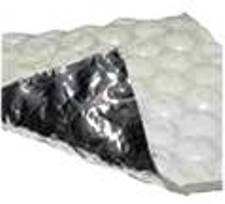Condensation will occur on any surface when the surface air temperature is at or below the “dew point temperature” for an air-water (vapor) mixture. The dew point temperature is the temperature at which the air can no longer “hold” all of the water vapor which is mixed with it, and some of the water vapor must condense into liquid water. The dew point is always lower than (or equal to) the air temperature.
The dew point temperature depends upon the dry bulb temperature (measured with an ordinary thermometer) and the relative humidity in the air space next to the surface. The dew point temperature is less than or equal to the dry bulb temperature. The two temperatures are equal when the relative humidity is 100%.
With an inside surface temperature of 70º Fahrenheit (F), and 50% relative humidity, the dew point temperature is 50.5º F. Bring the relative humidity up to 90% and the dew point is now at 66.9º F.
 Condensation can occur when the outside temperature is cold. Insulation below the steel roofing will create an inside surface temperature which is above the roof surface temperature. The actual temperature of the inside surface depends upon the amount of thermal resistance between the roof and the inside surface. The higher the resistance, the closer the interior surface temperature will be to the inside air temperature. Maintaining a reasonable inside relative humidity (less than 60%) is an important factor in preventing condensation.
Condensation can occur when the outside temperature is cold. Insulation below the steel roofing will create an inside surface temperature which is above the roof surface temperature. The actual temperature of the inside surface depends upon the amount of thermal resistance between the roof and the inside surface. The higher the resistance, the closer the interior surface temperature will be to the inside air temperature. Maintaining a reasonable inside relative humidity (less than 60%) is an important factor in preventing condensation.
A reflective radiant barrier below the roof steel results in an interior surface temperature which is greater than the outside temperature (in cold weather). As the inside air surface temperature increases, the conditions for condensation become less likely to occur.
A vapor barrier is highly recommended on the underside of any steel roofing. A vapor barrier is a layer of material having a permeance of less than one perm and is typically applied to a warm interior surface to prevent condensation. If interior air containing water vapor is allowed to come in contact with a cold roof surface, then condensation will likely occur. Any insulation system which does not include a high quality vapor retarder will be of little or no value in controlling condensation in cold weather.
Bottom line: Make sure your steel roof has an adequate vapor barrier beneath it to control condensation.






